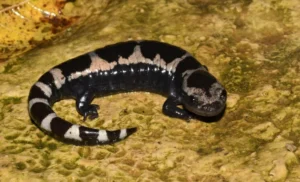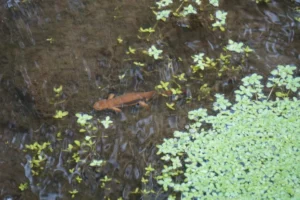Salamanders are fascinating creatures that live both in water and on land, depending on their species and life stage. Do salamanders breathe out of water?
Yes, many salamanders can breathe out of water, but how they do it depends on the species. Some use lungs like land animals, others absorb oxygen through their skin, and a few use both. Salamanders have adapted to breathe in water and on land in different ways.
How Do Salamanders Breathe?
Salamanders are amphibians, which means they have several ways to breathe depending on where they live and their stage of life.
Lungs
Many (not all) adult salamanders that live on land have lungs to breathe air. These lungs aren’t as advanced as those of mammals or reptiles, but they help the salamander take in oxygen from the air.

They gulp air into their mouths and push it into their lungs by swallowing or forcing air down their throat.
This lung ventilation mechanism is different from how humans breathe but works well enough.
Skin Respiration
Many salamanders have thin, moist skin that lets them absorb oxygen directly from air or water. This is called cutaneous respiration.
Oxygen passes through their skin into the bloodstream, while carbon dioxide leaves the same way. For this to work, their skin has to stay wet.
That’s why salamanders live in damp places and avoid drying out. Skin breathing is especially important for species with smaller lungs or none at all.
Gills
Some salamanders, especially larvae and species like axolotls that keep their juvenile form, have external gills to pull oxygen from water.

These feathery gills stay underwater and let the salamander breathe while swimming. These salamanders can’t breathe air well and must stay in water to survive.
Can Salamanders Live Out of Water?
Whether a salamander can live out of water depends on its species and adaptations.
Terrestrial salamanders live fully on land. They breathe with lungs and skin and usually return to water only to breed or lay eggs.
Aquatic salamanders like axolotls or sirens live mostly or completely underwater. They have gills and can’t survive long out of water.
Semi-aquatic salamanders split time between water and land, switching between gills and lungs as they grow.
If you take an aquatic salamander out of water, it can suffocate quickly unless it has well-developed lungs or moist skin for breathing through the skin.
How Do Salamanders Manage Breathing Changes?
Many salamanders change how they breathe as they grow. They start as larvae with gills to breathe underwater. As they mature, most lose their gills and develop lungs for breathing air.
Some, like axolotls, never lose their gills and stay aquatic all their lives. This is called neoteny.
This breathing flexibility lets salamanders adapt to different homes and lifestyles.
Why Is Moisture So Important?
Because salamanders rely a lot on skin breathing, they must keep their skin moist. Dry skin blocks oxygen and can quickly cause suffocation.
That’s why you’ll often find salamanders in damp forests, under logs, or near streams. They avoid dry or hot places because those conditions threaten their breathing.
If a salamander dries out, it won’t survive long even if it has lungs.
What About Breathing Underwater?
Salamanders that live in water mostly use gills or skin to breathe. Some can also absorb oxygen through their mouth lining or other membranes.

Unlike fish, salamanders don’t have scales protecting their skin. Their skin stays very thin and permeable for oxygen exchange.
This also means they are sensitive to water quality. Polluted or oxygen-poor water can cause serious health problems.
Can Salamanders Hold Their Breath?
Yes, salamanders can hold their breath underwater for several minutes, depending on the species and water conditions.
When resting or hiding, they slow their metabolism and reduce oxygen needs. This helps them survive in low-oxygen or murky water for a while.
But eventually, they need to come up for air or move to oxygen-rich water.
Conclusion
Many salamanders can breathe out of water, but how they do it depends on their species.
Land species mainly use lungs and skin. Aquatic species rely on gills and skin. Keeping their environment moist and clean is vital for healthy breathing.
This flexibility helps salamanders live in different places, from forest floors to ponds. But it also means they’re vulnerable to drying out or poor water quality.
If you care for salamanders, maintaining proper moisture and clean habitat will help them breathe easily both in and out of water.
Hi, my name is Ezra Mushala, i have been interested animals all my life. I am the main author and editor here at snakeinformer.com.

